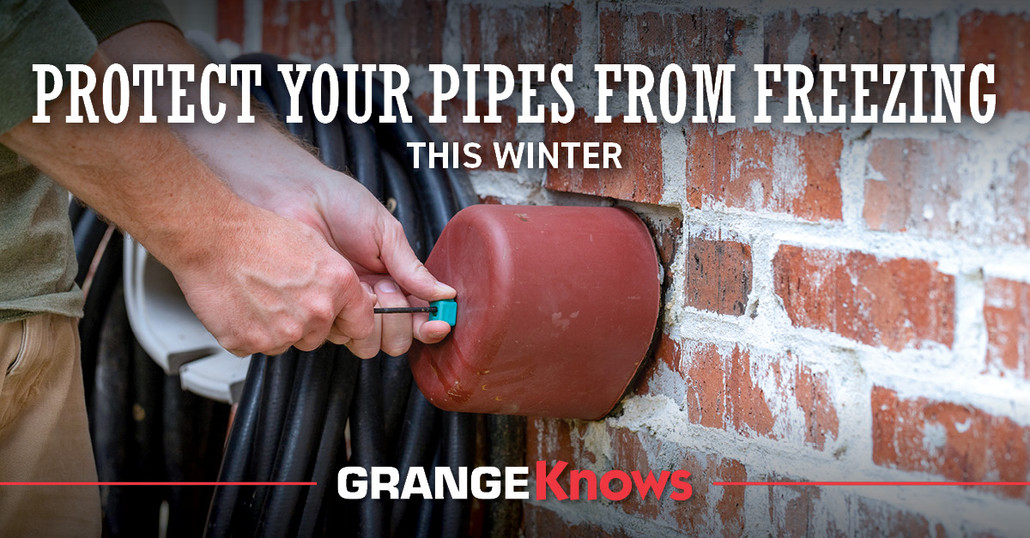
Protect Your Pipes from Freezing This Winter
Posted by Grange Co-op on 27th Dec 2022
Colder temperatures are already upon us, but it's never too late to take steps to protect your pipes.
The Main Reasons Water Pipes Freeze
There are three primary causes of pipes freezing:
- The temperature drops suddenly.
- The pipes aren’t insulated.
- The inside temperature is set too low.
Preparing your home now can help prevent pipes from freezing, saving you time and money in the long run. Insulating pipes, checking for leaks and investing in needed materials before the first storm of the season is crucial. Start by adding the right type of pipe insulation to all your exposed pipes.
Use Pipe Insulation
Exposed pipes are most vulnerable to freezing and bursting. It isn’t just those under your kitchen and bathroom sink either. Insulate pipes in the attic and crawl spaces. There are a few different ways you can insulate your pipes:
- Conventional foam pipe insulation is fast and easy to apply over pipes. It has an open slit on the side, so it fits existing pipes. Some types have an adhesive strip that you pull tape from and seal the foam together. If yours doesn’t, you should use tape to wrap around it and keep both sides close together. Check the size of your pipes before you order. Each type of foam pipe insulation specifies the type and size of pipes that it works with.
- Pipe wrap is made of fiberglass, and it fits pipes of any diameter. It is good pipe insulation for exposed pipes and works on those carrying both hot and cold water.
- Pipe heating cables keep pipes from freezing using a built-in thermostat. They automatically heat up only when needed. Choose from a variety of lengths to fit your needs.
Look for Leaks
Find and thoroughly seal leaks around windows, electrical wiring, dryer vents, doors, etc. Use the appropriate sealant for the job. Since heat follows cold, your treated air will go outdoors any place there is a tiny crack or cranny. Failing to seal cracks also means the hot air will find its way into your home during hotter weather.
If you live in an older home, you are more prone to leaks around windows and doors. After sealing cracks around the window seals, cover each window with a shrink-to-fit window kit. This is a simple and cost-effective method for sealing windows against the cold.
Adjust Your Thermostat
Freezing occurs at 32°F. Outdoors, wind can cause the temperature to feel much colder. Why, then, do most experts recommend setting your thermostat no lower than 50°F even if you aren’t going to be at home?
The simple answer is that most thermostats don’t go any lower than that. Once you get to 50°, you’re heading into air-conditioning territory. The only way to set the temperature any lower is to cut the thermostat off altogether. That would make your home vulnerable to those sudden drops in temperatures that cause pipes to freeze.
If you are going out of town over the holidays, don’t turn off the thermostat. Set it at the lowest setting (no lower than 40° for those who go down that far.) You will still save a lot on heating costs and keep your pipes from freezing while you’re gone.
Also, open up cabinet doors under the sinks and doors to rooms that you normally keep closed off. Allow the warm air in your house to circulate without creating any cold zones that might cause pipes to freeze.
Turn On Your Faucets
Water mains have enough water flowing through them that they aren’t likely to freeze. However, if it’s cold enough, the water can freeze in the pipes where it comes into your house. Letting both hot and cold water drip keeps the water circulating and prevents it from freezing. The hot water also helps prevent water in the drain going out of your house from freezing.
Keep track of the weather and when the temperature or the wind chill factor is expected to get to 32° or lower. That’s when you need to turn on your faucets to a drip or a very light stream. The cost of hot water will be minimal. The damage caused by frozen burst pipes can reach thousands of dollars.
Head Outdoors
Remove water hoses from outdoor faucets and turn off the indoor valve where possible. Drain the water from any indoor pipes. Otherwise, the faucet can freeze in the pipe just inside your house. Use faucet protectors to cover outdoor faucets to prevent them from freezing and also keep air from getting inside.
Don’t Forget the Livestock
Depending on how you get water for your livestock, keeping them hydrated during the winter can be challenging. Foam pipe insulation can help keep outdoor faucets working near the barn too.
If you keep water in buckets, barrels, or small ponds, we have solutions for that as well. Browse our range of floating de-icers, tank de-icers, heated buckets, and more. Make sure your animals have access to fresh water all winter long.
Get Ready for Winter at Grange Co-op
At Grange Co-op, we have what you need to winterize your home before the freezing temperatures settle in! Shop our range of pipe insulation, de-icing solutions for your animals, and sealants to create a formidable barrier against the cold. If you need help choosing the right products for your home, we’re here to help. Contact us or drop by your local Grange Co-op.
